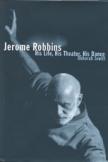Dancing for Identity
The one story that everybody in the theater tells about Jerome Robbins has him angrily giving notes to his dancers (in either “West Side Story” or “Billion Dollar Baby”), while backing away and then falling into the orchestra pit. And no one says a word or makes a move to help him—either from fear of the furious figure or from pleasure at his comeuppance.
Robbins was notoriously difficult, a perfectionist who demanded everything of his performers and still more of himself. Deborah Jowitt’s major new biography tells of “the temper tantrums of a child” and language that could “skin the soul of a dancer.” Still, both women and men fell in love with him, and the world embraced his work.
Helen Gallagher said, “I would sell my soul to the devil to work with him.” Chita Rivera stated, “He’s responsible for so much of whatever there is that’s professional and good about me in the theater.” In Jerome Robbins Jowitt describes her subject as both alarmingly volatile and sometimes apparently murderous, yet also as an astonishingly sensitive genius who remade the American musical.
Jerome Wilson Rabinowitz was born on Oct. 11, 1918, to an immigrant Russian couple who lived in Weehawken, N. J. Harry and Lena were intent on their children’s education but were difficult parents. “I do think he’d stop breathing if he thought air cost money,” Robbins once wrote of his father—who also let the boy know that his conception had been an excuse to escape the draft.
Lena was equally formidable. At least once, and maybe more often, anger with her son led her to pretend to dial the phone and say: “Hello, is this the orphanage? Come and get my boy. I don’t want him anymore.” But when the son began to taste success and chose the name Robbins, they did also. And he cared for them, if somewhat guiltily, until the end of their lives.
After he spent an unsuccessful year at New York University, Robbins’s older sister helped him to join Gluck Sandor’s Dance Center in 1936. Sandor’s group performed modern dance, but he persuaded his young recruit to study ballet as well. The small, slender dancer had talent, which was honed further at Camp Tamiment in the Poconos and by work with directors like George Balanchine. His first big break came in 1941, when Agnes de Mille cast him in “Three Virgins and a Devil” for Ballet Theatre.
While working at Ballet Theatre, Robbins was recognized and praised by the great dance critic Edwin Denby, who remained a lifelong friend and supporter. At age 24, Robbins created “Fancy Free,” with music by another rising star, Leonard Bernstein. The ballet opened in 1944 to more than 20 curtain calls—a runaway hit.
The triumphs that followed were many. Between 1944 and 1955 Robbins did a musical comedy and one or two ballets nearly every year. Expanding “Fancy Free” into the musical comedy “On the Town” (1944), Robbins reveled in collaborating with Bernstein, Smith, Betty Comden and Adolph Green and the veteran director George Abbott. He performed and choreographed for N.Y.C.B., and on Broadway his hits included “Call Me Madam,” “The King and I” and “Bells Are Ringing.”
But a man of desperate insecurity, he led a tumultuous personal life, including multiple affairs with men and women. His life took a wretched turn when the House Committee on Un-American Activities called him on the stand in 1953 and he named names. This cost him many friends and opened an inner wound in Robbins that never healed.
Still, his talent was indomitable, and landmark successes followed: “West Side Story” in 1957, “Gypsy” in 1959, “Fiddler on the Roof” in 1964. In the late 1950’s he founded a company, Ballets: U.S.A., which had great success in Europe. In 1966 he created the American Theatre Laboratory. In 1969 Robbins returned to N.Y.C.B., where he made one of his greatest ballets, “Dances at a Gathering,” to piano music by Chopin.
Jowitt, who has been the principal dance critic for The Village Voice since 1967, traces Robbins’s last years with the same sympathetic care she brings to the rest of this exhaustively researched, painstakingly detailed biography. It is thrilling to read of his late successes and saddening to note the deaths of his parents, a variety of lovers and his invaluable assistant, Edith Weissman. (The one person who seems simply to disappear toward the end of the book is Tanny Le Clercq, whom Robbins probably loved longest and best through all his life.)
Jowitt does tend to pile on detail, but nevertheless excels in describing the ballets and in evoking Robbins’s style, with his fusion of music and dance, his eye for the whole, his magical use of space, his acute visual sense and theatricality, and his typically relaxed, American use of the neo-classical ballet vocabulary.
At the time of his death in 1998, Jerome Robbins was the greatest American-born choreographer in ballet. His cultural achievements and numerous honors, however, did little to assuage an anguish of self-loathing and insecurity. It is for each of us to measure the scope of that anguish. Balanchine once made a remark to Robbins that he treasured all his life: “We penetrate into that place of silence which everyone is terrified of.... It’s the place with no words & no names & no objects.”
This article also appeared in print, under the headline “Dancing for Identity,” in the January 3, 2005, issue.








